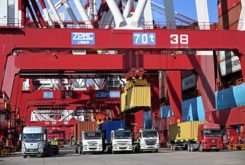The Brazilian economy’s potential, the opportunities to acquire cheap assets and the aggressive model of China’s investments in emerging countries are factors that are driving the increasingly intense and fast-paced presence of China in the South American country. Its presence is mainly felt in infrastructure projects such as energy, mining, agro-business and transportation – sectors that the Brazilian government is now working on diversifying.
“At our meetings with investors, we always ask for them to diversify and add value in Brazil. We insist on those two things. And that is what is actually happening, not just because in some way they are listening to what we say, but because they are seeing business opportunities,” says the Planning Ministry’s Secretary for International Affairs, Jorge Arbache.
He explains that the change began last year, when the Chinese entered sectors such as manufacturing and services. The latest bulletin on Chinese investments in Brazil, released by his ministry last January, indicates that the projects announced in 2017 encompass activities in financial services, pharmaceuticals/chemicals and transportation logistics, along with electric power generation and transmission. The volume amounting to US$13.9 billion also includes projects involving telecommunications and water catchment, treatment and distribution.
According to that survey, 2017 was the second best year since such monitoring began in 2003, with US$20.9 billion, only ranking behind 2010, when US$38.5 billion were recorded in the books. Overall, some 251 projects were announced or confirmed from 2003 to 2017, totalling more than US$123 billion.
Mutual interest
Secretary Arbache believes that the stronger bilateral relationship, especially in business, is part of the process of mutual learning and discovery. The more consolidated presence of the Chinese in the country, noticeably from the investment standpoint, is relatively recent, since around ten years ago. They arrived with strong expectations to do good business with short-term returns, motivated at the time by the Brazilian economy’s positive performance. In 2010, for example, its GDP closed the year up 7.5%. That was the best result in 24 years, since it increased by the same percentage in 1986.
But when the crisis arrived in 2014, some Chinese companies were frustrated to see their business plans, and profits, roll back.
A look at the Brazilian business market’s profile shows the presence, among others, of groups from Germany, France, the Netherlands and the United States, who have been here for more than a century, states the Secretary for International Affairs. During that time they have become thoroughly familiar with how the country’s economic and political structure works.
However, time is now beginning to favour the Chinese as well. Arbache says that when the movement and profile of Chinese investments are examined, it is possible to clearly discern that they have a better understanding of Brazil, which makes it easier to identify business opportunities. They have evidently learned about various aspects of the national economy and politics, including the legal and regulatory questions that are important for project planning and implementation.
He opines that the interaction between the two countries, characterised by their large economies and markets, has all that’s needed to develop a productive and long-lasting relationship from the economic and political as well as the academic, cultural and technological standpoints. “There’s no going back in the Brazil/China relationship. There’s much more to do. We’re going through a period of getting to know each other better.”
While the Chinese are making efforts to understand how Brazil works, driven by the appetite for substantial earnings, the Brazilian government also has high hopes that the bilateral relationship can be very profitable for both sides. Beyond attracting investors, Brazil wants to attract long-term greenfield investments with a diverse profile, and for them to bring new technologies, Arbache states. Those four characteristics pervade talks with the Chinese when business undertakings are the subject.
“The Chinese know that the (Brazil-China) relationship will get correspondingly stronger as it encompasses a broader agenda. That’s clearly on the table and they’ve understood,” he stresses.
The Secretary recounts that the Chinese have been very sensitive to that dialogue with the Brazilian government. And there’s no reason for them to have a different outlook. Brazil is one of the world’s top ten economies. “You can’t think of a global presence without being in the biggest economies. Moreover, you can’t think about having a global presence without being in Latin America (…). What’s the biggest market, which country has the most opportunities in the region? It’s Brazil. Regardless of anything else, whoever’s looking to have a worldwide presence has to be in Brazil. There’s no choice (…), and they’ve perceived that,” he emphasises.
While Chinese capital is showing increasingly obvious signs that it has come to stay, the Brazilian government has been implementing macro- and micro-economic reforms to improve the business environment and guarantee more predictability – a key word in the business world – for investors. Among the many changes are the lower basic interest rate, modernisation of labour laws, control of inflation, cutting red tape in the agriculture, services, retail and foreign trade sectors, and tax simplification.
Other steps have also been taken to boost credibility and the interest of foreign capital in Brazil. They include the law on state enterprises’ responsibility and consequent changes in the governance of such companies, streamlined regulations in the natural gas market, making it more competitive and breaking Petrobras’s monopoly, and the new law which provides legal security to investments in existing concessions, enabling them to be renewed before the respective expiration dates.
The aim is give foreign investors a more predictable business environment in which they know the rules of the game. That way it’s a matter of evaluating, identifying and measuring risk, Arbache affirms.
The Chinese are accordingly showing ever more confidence. In the last two months of 2017 alone, for example, two projects were disclosed, totalling US$6.7 billion, the Planning Ministry indicates. One involves complementing the acquisition of shares of CPFL Energia by State Grid, together with ESC Energia S.A., which upped the Chinese company’s joint stake from 54.65% to 94.75% of the company’s share capital. The other project concerns formalisation of the agreement between Eletrosul and Shanghai Electric to invest in 2,100 km of power lines and transformation capacity in the country’s southern region.
In the last two months of 2017, the Chinese invested US$6.7 billion into two projects in Brazil, amongst others.
It is noteworthy that most Chinese investments in national territory between 2003 and 2017 involved companies with public capital, such as China Three Gorges, Sinopec and State Grid, which accounted for the biggest slice of the US$123 billion envisaged and confirmed during that period, according to the Planning Ministry’s bulletin. China has been Brazil’s top trading partner since 2009.
And in this positive context, the two countries joined to form the Brazil-China Cooperation Fund for Expansion of Productive Capacity. Launched in May 2017, it now counts a portfolio of 31 projects. Six of them are on the agenda of the first meeting of the Technical Working Group, to be held by early March.
Of the US$20 billion that will comprise the fund, up to US$15 billion will be contributed via the Chinese Cooperation Fund for Investment in Latin America (Claifund). The rest will be formed by investments from Brazilian financial institutions such as Caixa Econômica Federal (CEF) and Banco Nacional de Desenvolvimento Econômico e Social (BNDES). Those are the preferential operators, though participation is also open to other Brazilian financial institutions.
Jorge Arbache explains that the fund is certainly acting as a “galvanising factor” with respect to the ever increasing Chinese presence in Brazil.
How does it work?
The cooperation fund is a facility established by the Secretariat for International Affairs (SEAIN) of the Planning Ministry and by Claifund which will classify projects the Brazilian government deems to be priorities in sectors such as logistics and infrastructure, energy and mineral resources, technology, agriculture and manufacturing, among others.
According to the ministry, there will be no input of public resources. For each R$1 invested by financial institutions, Claifund will put up R$3. The fund will operate in Brazil; its structure comprises a Management Board, Technical Working Group and Executive Secretariat under the responsibility of the Planning Ministry’s International Affairs Secretariat.
Projects must be submitted by means of formal proposals sent to the Executive Secretariat. The group will then evaluate them and present a proposed classification to the Management Board, which has joint administration, for the final decision. There are six members: three Brazilian and three Chinese representatives.
The Management Board’s analysis process involves classifying projects deemed as priorities by the Brazilian government in various activities such as infrastructure, manufacturing, agro-business and technologies that can facilitate industrial capacity cooperation between Brazil and China.
The projects so classified will receive a certificate to be presented to potential financers. They will follow their own rules to evaluate and determine the financing or investment conditions. Classification does not imply the right to receive financial support. The fund will solely certify projects to be developed in Brazil.
Although Brazil and China established diplomatic relations more than four decades ago, it is only in recent years that trade has become more intense. Since 2009 China has been Brazil’s top trading partner; major infrastructure investments have marked the presence of Chinese capital in states such as São Paulo, Maranhão and Goiás.
Data compiled by the Brazil-China Business Council (CEBC) indicate substantial investment in energy, made possible by concession auctions held by the Brazilian government. Between 2010 and 2016 investments of around US$42.5 billion were announced for the energy sector, corresponding to just over half of total Chinese investment announced for Brazil during that period. Analysis of the value of implemented investments is even more revealing. That sector, especially hydroelectricity, oil and gas, received support amounting to nearly US$34 billion, equivalent to 76% of all Chinese investment in Brazil between 2010 and 2016, according to the CEBC.




